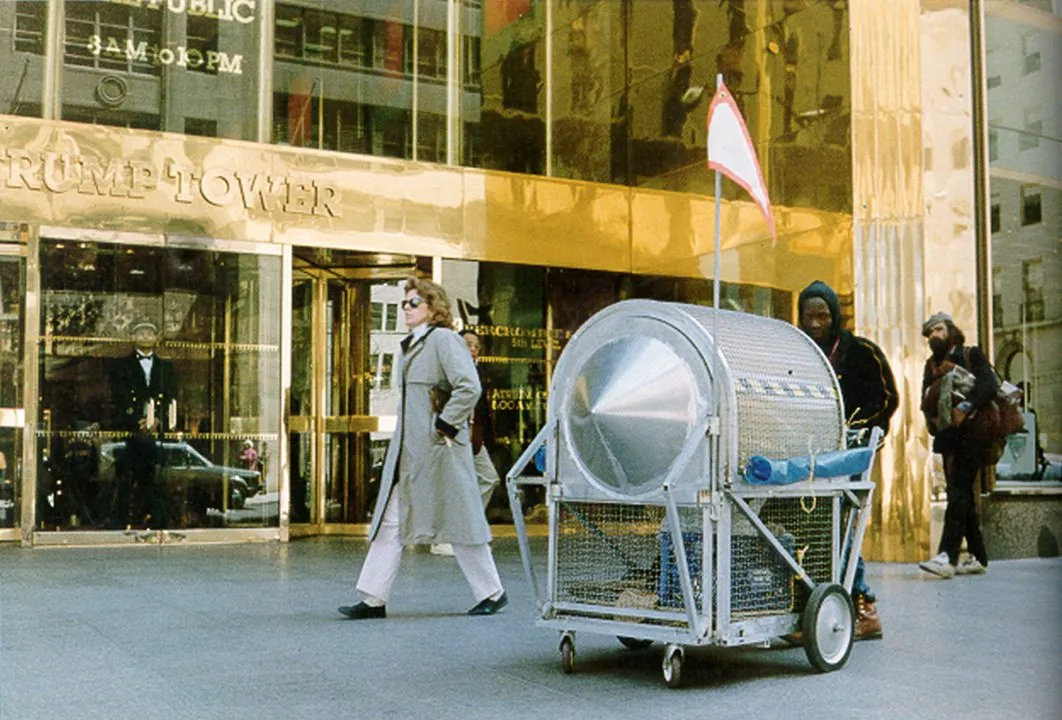How an Exquisitely Designed Cart for Homeless People Inspired a Wave of Artists’ Activism
In the 1980s artist Krzysztof Wodiczko’s vehicle of change was also a weapon of social disruption
/https://tf-cmsv2-smithsonianmag-media.s3.amazonaws.com/filer/ed/4e/ed4e4f17-1c4c-4e9a-9721-244a4baa49f4/gl_3476_-_homeless_vehicle_variant_5_a.jpg)
One day in the late 1980s, a homeless man in a red cap walked through a park in New York City, pushing a strange, wheeled object. The thing looked like a cross between a shopping cart and a rocket ship, with an arc of safety-orange fabric stretched over the top. The man paused to pick up a discarded beer can and tossed it in the cart’s basket.
A camera followed him, and a small crowd gathered as the man parked the vehicle and began to demonstrate its functions. He tugged on one end, and the object expanded to three times its original length. He pulled at another spot, and a retractable seat slid out. “It’s like a mobile home,” he said. The cart had a storage area for personal belongings, a washbasin that doubled as support for a table, a bin to hold cans and bottles, and, beneath its orange roof, just enough space for a desperate homeless man to sleep.
The cart’s creator, Krzysztof Wodiczko, was not on camera that day. He is a Polish-born artist who in the late 1980s began making several of these houses-on-wheels, which he called Homeless Vehicles. One of them, Homeless Vehicle, Variant 5, from 1988-1989, is now among the collections of the Smithsonian’s Hirshhorn Museum and Sculpture Garden.
Wodiczko, who had begun his career as an industrial designer, spent hours consulting with homeless people who collected bottles and cans for a living, asking about their needs and seeking feedback on his designs. By presenting an idea of emergency housing both elegant and disturbing, he hoped to raise awareness of the homeless and their concerns. The Homeless Vehicles helped launch a renewed interest in social activism among artists, an interest that can be seen today in forms that range from the neighborhood development projects of Rick Lowe to Yoko Ono’s Twitter feed. “The question is,” Wodiczko said in a recent interview, “What can we do as artists to be useful in our work?”
Born in Warsaw in 1943, Wodiczko lived in Communist Poland until moving to Canada in the 1970s and later to the U.S. Arriving in New York in the 1980s, the artist was shocked by a “catastrophic situation”: tens of thousands of people living without homes in that wealthy city. The can and bottle collectors stood out, pushing shopping carts wherever they went. Though they were dismissed by the public “much as every other homeless person, faceless, seemingly using stolen consumer equipment,” he says, he saw them as working people doing tough jobs that benefited the city, day and night, for very little money in return. In the Homeless Vehicles, he tried to “create a legitimate vehicle for collecting bottles and cans, so these people will be recognized as legitimate members of the urban community.”
It one sense Homeless Vehicle is exquisitely functional, almost charming in the way it squeezes so many useful features into one neat, rolling package. Artists have created functional objects forever, usually for the wealthiest stratum of society, whether ancient Chinese incense burners or opulent Art Deco doors. Some artists, in the Bauhaus of the 1920s, for example, designed mass-produced goods for a broader public. But it was something new, says Stéphane Aquin, chief curator of the Hirshhorn, for an artist to create a beautifully functional tool for the poorest of the poor. “It was designed for the use of those who need it the most,” he says.
Looked at another way, though, Homeless Vehicle isn’t functional at all. As either a real home or a long-term solution to the shortage of affordable housing, it’s absurdly, even horribly, inadequate. Wodiczko says he didn’t intend for the vehicles to be mass-produced, and he didn‘t give away even the few that were made (partly because he feared they would be so desirable that people would get hurt fighting over them).
Instead, Homeless Vehicle can be understood as a critique of economic inequality. Among the places where one of the artworks was photographed was in front of Trump Tower. Aquin sees the absurdity of the vehicle as Wodiczko’s metaphor for “the absurdity…of the extreme capitalist society of the late 1980s: the trickle-down economics of the Reagan years, the rise of Trump Tower, a dramatic rise in homelessness in New York City.” Even with all its homey amenities, Homeless Vehicle looks a lot like a missile. One of its intended functions was as a weapon of social disruption.

They may not have known it, but the people in the park gawking at it were part of the artwork, too. Wodiczko says that the vehicles were addressing two different emergencies: a need to make homeless people’s existence a little less harsh, and an equally urgent need to give this mostly ignored group of people a chance to be heard, to “speak of their lives to nonhomeless people.” In this sense, he says, the can and bottle collectors who worked with him turned out to be performers. As they wheeled his strange vehicles around the city, they attracted questions from passersby, which led sometimes to friendly conversations between homeless people and their neighbors or, sometimes, to outrage (“We can’t have 100,000 vehicles like this!”). Either way, the discussion was part of the point. It was, Wodiczko says, “on one hand, emergency help; on the other hand, a situation for thinking.”
Looking back on it as a piece of art history, Aquin says that Homeless Vehicle “raised awareness in the art world about social issues” and about the ways artists could apply their creativity to solving social problems.
If Wodiczko’s social activism was unusual among artists in the 1980s, in the decades since it has rippled into many parts of the art world. Nato Thompson, artistic director of the cultural organization Philadelphia Contemporary and author of Seeing Power: Art and Activism in the Twenty-First Century, has seen a significant rise in what he calls “socially engaged art” in the last decade or so, of “artists interested in using their skills to better their communities.“ He adds, “Even the conversation of community as a part of art has grown tremendously. It’s not only artists, but there are more institutions supporting it, and more foundations.”

Activism has influenced a range of art made since the Homeless Vehicles’ era. Aquin sees their humor and absurdism as an older sibling of “ludicrously satirical” work like the Yes Men’s Survivaball from the early 2000s, a bloblike suit supposed to protect the wearer from climate change. Wodiczko’s own work has continued to give marginalized people—from immigrants to abused women to military veterans—a platform to speak publicly, now often in large-scale audio and video projections. (His 1988 projection Hirshhorn Museum, Washington, D.C. was recently restaged at the museum.) Meanwhile, as Thompson points out, other artists have gone on to address problems of homelessness and affordable housing, such as Michael Rakowitz with paraSITE, a series of inflatable plastic shelters, or Rick Lowe and Project Row Houses, an artists’ urban renewal project in Houston.
The Danish artists’ group Superflex has focused on functional art addressing social issues, from a series of projects with biofuels in the 1990s to a recent work exhibiting and then donating medical equipment for a hospital in Syria. Mark Beasley, curator of media and performance art at the Hirshhorn, says the group continually grapples with the question of “how you create an active space for discussion”—in much the same way that Wodiczko hoped to provoke that discussion in a public park.
Thirty years after Homeless Vehicle, the Internet and social media have become natural places for public discussion. “Artists are very adept and very promiscuous in taking to new media,” Beasley says, as “another platform for discussion or dispersion of ideas.”
An 18th-century artist might have used history painting to comment on events, he says, but “rather than 10 people clustered around a painting,” an artist on social media can reach millions in a matter of seconds. “Artists are engaging in that in the same way that any corporate brand is engaging in that.” Beasley says that since much of Yoko Ono’s work is text-based, for example, it is a natural fit for social media. Jenny Holzer’s aphorisms, he says, are a form of discussion, whether they’re projected onto the side of a building or posted on Twitter.
The discussion continues. Thompson says he hasn’t seen a dramatic change in artists’ work since the election of Donald Trump as president, but it may be coming. “The arts take a while to recalibrate themselves,” he says. “The shift to dealing with the new political atmosphere I don’t think has happened yet.” At the moment, he says “we don’t have a large protest movement going on in serial way,” with regularly repeated protests like those around the Vietnam War, AIDS or civil rights, which often galvanized political art in the past.
For now, Wodiczko’s Homeless Vehicles tell us something about what art can accomplish, and what it can’t. Innovative as they were, the vehicles didn’t shift public opinion enough to replace homes-on-wheels with real housing for those in need. More than half a million people were homeless in the U.S. on a single night last year. And so Homeless Vehicle, Variant 5 serves to remind us, Aquin says, “that solutions still need to be found.”
Homeless Vehicle, Variant 5 is on view at the Hirshhorn Museum and Sculpture Garden as part of the exhibition “Brand New: Art and Commodity in the 1980s” through May 13.
/https://tf-cmsv2-smithsonianmag-media.s3.amazonaws.com/accounts/headshot/SusannahGardiner.JPG)


/https://tf-cmsv2-smithsonianmag-media.s3.amazonaws.com/accounts/headshot/SusannahGardiner.JPG)